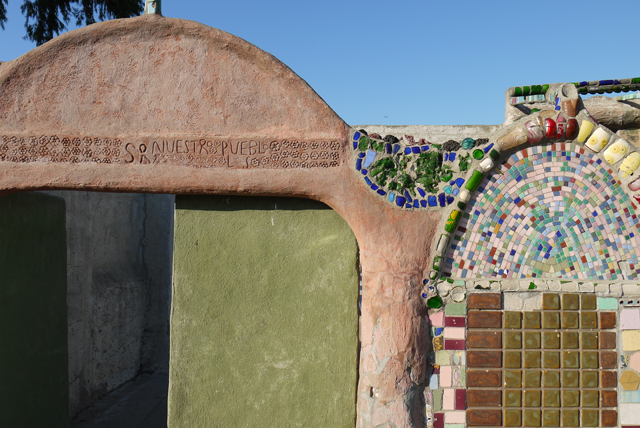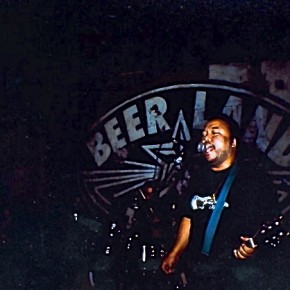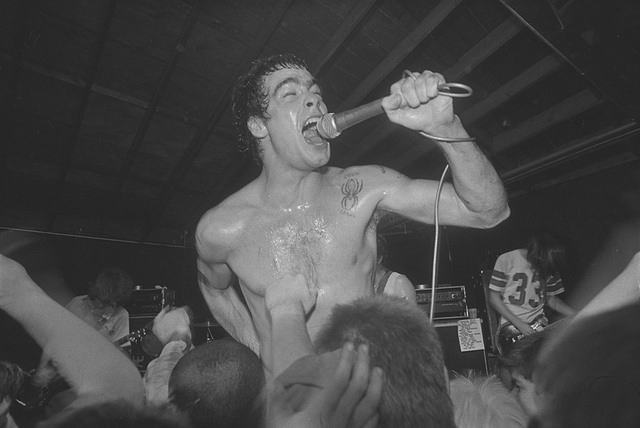Their proximity is in the back of my mind, as I motor up Central, but, after decades of wanting desperately to see them, I am suddenly reluctant. The point of this drive is to search out what gets overlooked, left out of the story, not the one landmark that writers have returned to over and over. But then I see the small, green sign with an arrow pointed rightward and relent: “Watts Towers”.
As I turn east onto 108th, I look for them on the horizon. With all that I’ve read about Simon Rodia’s labor of love, I don’t have a clue how big they are. Part of me wants to turn back, not because I’m scared to be here — I had just spent the previous hour driving the side streets of Compton, after all — but because I don’t want to be disappointed. It’s hard to believe that the towers could live up to their reputation as one of the world’s greatest examples of outsider art.
The longer I inch my way down the street, the more I begin to suspect, however irrationally, that I will end up finding a scale-model, “towering” only in shape, not size. But then I finally spy them, looming incongruously over one of the many homes in these parts that seem to be hosting a perpetual yard sale. In the photographs I’ve seen, they are always isolated from their surroundings, as if their significance depended on their standing alone. From this vantage, though, they seem to belong, somewhat incongruously, like those mobile phone towers dotting the Southland that are disguised to look like palm trees or giant succulents.
Once I hit Santa Ana, I turn left and double back. And there, suddenly, they are. I park and walk towards the towers. It’s too late for the complex to be open to visitors, but the protective fencing around the fragile masonry doesn’t seem to hide much. A few kids are sitting on the risers at the far end of what looks like a miniature concrete amphitheater — and likely skate park — on the north side. Three men walk in front of me as I approach, talking furtively. The way they look me over makes me a little uncomfortable.
But I keep walking until I reach the western edge of the fence. The view through its metal slats is more encouraging. The complex is no ruin, left to disintegrate slowly. Or no longer, anyway. I can tell that interesting educational activities take place here, that the people who care for the place really do care. Then I round the corner, so that I can take in the south side of the complex.
The late-afternoon sea light that made the Los Angeles Basin famous, that light which mid-twentieth century smog had threatened to dim for good, is slanting in low and strong. Looking west, the sky above is a white that pulses with golden promise; looking north and east, it’s as blue as it could possibly be. Rodia’s carefully placed bits of glass are radiant; the tight spirals of his towers perfectly backlit as I tilt my head upward. The air smells fresher than I’ve ever experienced in these parts. I am not disappointed.
Ahead of me, two African-American women are reading the plaques that detail Rodia’s labors. I had wondered, perhaps unfairly, whether the handiwork of an Italian-American immigrant who died the year of the Watts Riots would interest the neighborhood’s current inhabitants, whether some of them might even resent the attention they receive. Yet if these women are any indication, that’s not the case. “I want a picture of me in front of our towers,” the slim one says.
Her companion obliges, backing up to get as much height as possible in the frame. I notice that the woman who has requested the photograph sports a futuristic high-combed hairdo, streaked with aquamarine and purple. It reminds me of Janelle Monae, of the latest wave of Afrofuturism. Maybe I’m reading too much into her look, but it makes her first-person plural resonate in my mind. For all I know, she could be a tourist from Atlanta. But this is Watts and she is claiming ownership of this remarkable structure.
A few more people start to converge on the complex. One is obviously an outsider like myself, reverently photographing details through the fence. The others, though, seem local. A man walking his dog. A couple holding hands. Another kid, who takes a minute to stare at the towers before taking a seat on the risers. The weather is perfect, this makeshift park as pleasant as it could ever be. I can’t help but feeling, though, that the towers are improving everyone’s mood. They manage to be impressive without ever seeming intimidating. Few people would have the dedication to pursue this type of project to completion, certainly, but it’s not hard to imagine following in Rodia’s footsteps if one only had the time and energy.
That’s an illusion, of course. As I take in more views of the towers, I start envisioning construction projects I could undertake at home. Given my limited mechanical aptitude, the odds of making headway on any of them are incredibly remote. What strikes me is that I am able to ignore the painfully obvious for a time. Rodia, it seems, was as much a craftsman of hope as of masonry. Perhaps that explains why this handiwork feels so modern, philosophically. The towers don’t hide their principles of construction. They aren’t the product of magic, but of logic, demonstrating that love and reason can go hand in hand.
As I’m getting ready to leave, a quickening of the light directs my attention southward, to the houses across the street. They are modest, like almost all the single-family homes in this area. But they are more spruced up than most, communicating a warmth often sorely lacking in aging inner suburbs like this one. It may be pure coincidence that these houses stare out at the towers, but I don’t think so. How could their owners not feel inspired, when they look across the street every day?
The reason it took me so long to visit this place is also the reason why it seems so important. In a city where proximity to the freeway is the prime factor in determining what does and doesn’t get many visitors, the Watts Towers are too far from an exit — and too close to what, even now, counts as a “bad” neighborhood — to attract casual tourists. You have to really want to go there, to make a special trip. And that ensures that they remain part of their community in a ways that a high-volume tourist attraction never could.
Photographs courtesy of the author










